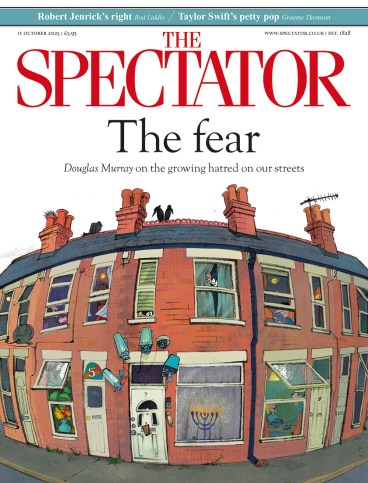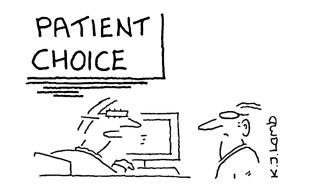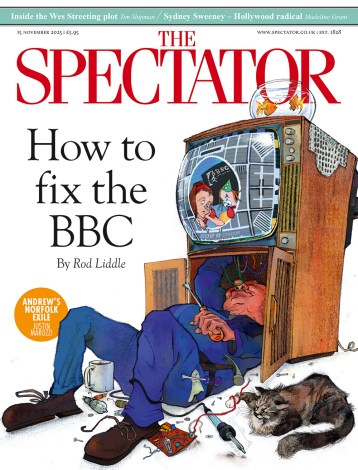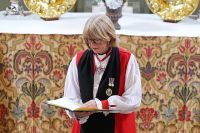
Theo Hobson has narrated this article for you to listen to.
Whatever you think of the new Archbishop of Canterbury, Sarah Mullally, there can be no doubt about this: she firmly backs the Church of England’s current official teaching on sex and marriage. Indeed, as the bishop who was recently in charge of updating that teaching, it might be the case that she upholds it more completely and sincerely than anyone else.
Perhaps some readers would like to be reminded what the Church’s current official teaching on sex and marriage actually is. It is this: marriage remains the preserve of heterosexuals. Homosexuals may have their unions blessed in church. Um… that’s it. That’s all that can be said for sure.
What about this obvious question: does the Church condemn sex outside of marriage? There is no clear answer. Some say that the old official teaching still stands. But this is hardly compatible with the fact that gay unions may now be blessed (there is no proviso that these unions must be chaste).
Or what about this question: can clergy be actively homosexual? Again, there is no clear answer. On the one hand, they cannot marry – they are not even permitted to enter into secular marriages. On the other hand, their unions can be blessed. According to a 1991 document, gay clergy must be celibate. This was the official teaching until a few months ago, when this document was rescinded. No new guidance has been issued.
Let’s state the obvious: the Church’s stance on sex and marriage is incoherent and contradictory. It must be honest about this if it is to have any chance of moving forward.
Before the 1960s, the Church’s teaching was solid enough. It can be summed up as ‘marriage good, sex outside of it bad’. Of course there were developments and controversies (divorce, contraception etc), but the old line was stable enough.
Then came premarital sex. One form of it was hard to oppose: a couple having sex prior to their wedding. So, when premarital cohabitation became common, the Church quietly condoned it. Of course it still wanted to exalt marriage and censure casual sex, so it stuck with the traditional teaching, but with less will to uphold it strictly.
Then came homosexuality. Well, it was already there, but it only commanded real attention from the mid-1970s. Liberal Anglicans began to accept it, or to turn a blind eye, assuming that this didn’t really affect the old teaching – for hadn’t a blind eye been turned to premarital sex, with no need to reinvent the wheel? But there was a huge difference. Heterosexuals could, after their premarital sex, marry. So liberal Anglicanism drifted to the assumption that the old teaching was still fit for purpose (if taken with a pinch of salt) for heterosexuals, but did not apply to homosexuals. In effect they should be treated as a different category of Christian. Because they cannot marry, let them have a sort of exemption from the general rule, let them work out their own sexual salvation.
The new Archbishop of Canterbury must question the magic aura surrounding these teachings
A few liberal thinkers were wiser. Jeffrey John stands out. He argued that what really matters is that sexual relationships, straight or gay, are permanent, faithful and stable, and that the Church should move towards affirming same-sex unions (though same-sex marriage was barely considered a possibility yet). But the average liberal Anglican was hesitant. Was it really worth destabilising the old teaching, with its majestic simplicity? It was easier to keep it in place and carry on treating gay people as exempt from it.
Meanwhile, the conservative evangelicals saw the need to tighten up the old teaching. In 1987 they persuaded the General Synod to declare that the Church only approves of sex ‘between a man and a woman who are married to each other’. Nevertheless, the liberal leadership continued to condone gay clergy. Then in 1991 came that document, ‘Issues in Human Sexuality’, clarifying that gay clergy should be celibate. But, significantly, it did not apply this rule to lay homosexuals, instead saying that their faithful unions should be nurtured. Liberals took this as a hint that the rule about gay clergy shouldn’t be taken very seriously.
Then in 1998 the global Anglican Communion echoed the ruling of 1987: no sex outside of marriage. But such tightening up had no real effect, like a screw-top lid that has lost its thread. The liberal leadership carried on condoning its gay clergy and assured them that greater inclusivity was coming soon. For another 25 years, very little changed, except for a ramping-up of the rhetoric of grievance on both sides.
On one level, the advent of same-sex blessings in 2023 was just an acknowledgement of the reality that had existed for decades. But it was a major breakthrough, for it spelled the end of the old official teaching: ‘No sex outside straight marriage.’ The Church now affirms gay unions, in which sex is presumed to take place. The Rubicon has been quietly crossed.

An example of the shift came last year, with Justin Welby’s comments prior to his resignation. He told The Rest is Politics podcast that stability and fidelity are what mattered in relationships, straight or gay. The strong majority of bishops are of this view.
The Church has therefore changed its position on sex and marriage – but so far in a muddled and negative way, without daring to articulate a positive new vision. It has edged away from the old official teaching, which hadn’t been taken very seriously for decades anyway. By blessing gay unions, it implies that sex outside of marriage is permissible. Yes, it still holds to the traditional doctrine of marriage, but this has become a frail technicality, certain to totter. Also, it has quietly developed an unofficial teaching: what really matters is that sexual relationships are faithful and stable. But it has not yet dared to say this explicitly.
Archbishop Mullally must dare to do so. This means questioning the magic aura surrounding marriage, which has the semblance of highest sacredness but is in fact a human tradition. Has she, alongside her chief-nurse dedication to duty and loving service, the necessary dose of iconoclastic coldness?








Comments